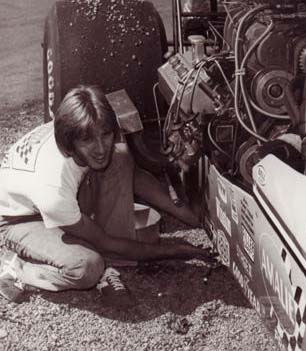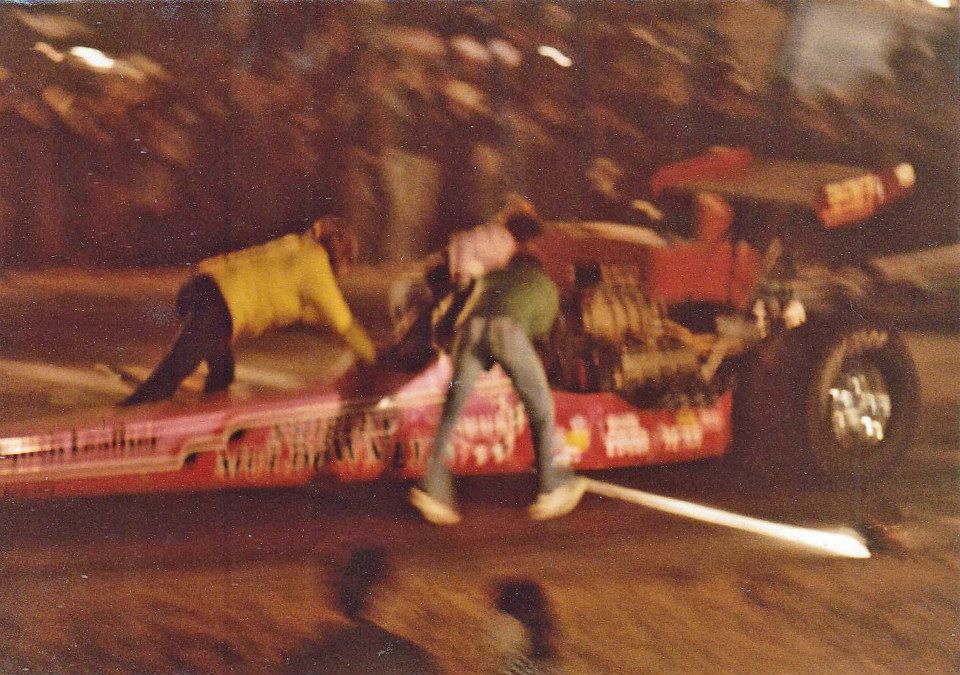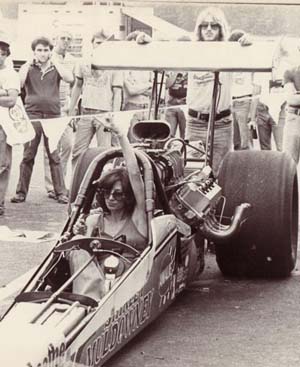BIG VS. SHIRLEY: WHEN THEY RAN SPARTANBURG DRAGWAY …
 John Muldowney, son of four-time Top Fuel champion Shirley Muldowney, worked many match races with his famous mother in the 1970s and retains a photographic memory of those outings. They match raced Don Garlits at many of the larger tracks such as Orange County International Raceway, Irwindale Raceway and Raceway Park in Englishtown, NJ.
John Muldowney, son of four-time Top Fuel champion Shirley Muldowney, worked many match races with his famous mother in the 1970s and retains a photographic memory of those outings. They match raced Don Garlits at many of the larger tracks such as Orange County International Raceway, Irwindale Raceway and Raceway Park in Englishtown, NJ.
However, for every one of those larger tracks, there were a few of the backwoods venues on the schedule; And, John Muldowney remembers them all.
March 1979, and the night his mother match raced Garlits at Spartanburg Dragway in South Carolina, remains one of his fondest memories.
“A unusually nice southern warm evening,” Muldowney said. “We were running our low compression motor at the time, an 80 out engine. It was kind of a good little match race motor because it had big flames and it had a roar of a lion, but it was real mellow and would go down slippery tracks real easy.”
Spartanburg Dragway was a nice small-to-medium sized facility built in the early 1960s that had played host to some of drag racing’s early stars. However, those stars, Butch Leal, Roy Hill, and Hubert Platt ran carburetors and gasoline. Prior to the Big-Shirley match race, the last time nitro cars ran at Spartanburg was in 1974, during Tom “Smoker” Smith’s East Coast Funny Car match race series.
 When the word was broadcast over WORD 91 AM that Garlits and Muldowney were coming to Spartanburg, the community responded in a big way. Old Canaan Road, the small two lane highway that ran by the drag strip, was backed up with cars for nearly three miles all the way to [four-lane] SC Highway 221, where it was backed up for nearly a mile at times. The other pathway into the track, and the road this writer lived on, Hwy 88, was backed up as well.
When the word was broadcast over WORD 91 AM that Garlits and Muldowney were coming to Spartanburg, the community responded in a big way. Old Canaan Road, the small two lane highway that ran by the drag strip, was backed up with cars for nearly three miles all the way to [four-lane] SC Highway 221, where it was backed up for nearly a mile at times. The other pathway into the track, and the road this writer lived on, Hwy 88, was backed up as well.
It’s believed that track promoter Jimmy “Hercules” Boyd had as many as 13,000 spectators that night, a considerable increase over the 3,000 max usual that had packed the place on a marquee night.
“They were turning them away at the gate,” Muldowney recalled. “There were no more places to park cars and the stands were packed.”

The match race was run based on standard procedure, best two out of three and the first run would take place during the day, so that racing could finish up under the lights and most importantly before the midnight curfew.
“We went up for the first round, and there wasn't much track there so we set it up to just go down the track,” Muldowney explained. “We ran a 6.35 to his 6.41 or something like that and we beat him. So we came back to the pits and didn't even take it apart. Everything was good.”
Spartanburg Dragway, unlike many of the larger venues, kept its starter inside of the tower, and operated the tree from inside there.
“(The starter) was just a young kid they hired for the weekend,” Muldowney said. “[Garlits] told him he was going to let (Shirley) stage first in the next round. ‘When I light my second light you drop the tree automatically' Garlits told him and the kid agreed to do it.”
Garlits took the second round, although the Muldowney team came to the line prepared to beat him.
 “We hopped our tune-up a little bit,” Muldowney added. “It seemed like the track was a little better than we thought, so we stepped it up. And, they staged and when he lit the second bulb it was yellow, green, gone and he left on my mom by about two car lengths. We ran a .24 and he ran .27 and beat us because he was so far out on the leave.
“We hopped our tune-up a little bit,” Muldowney added. “It seemed like the track was a little better than we thought, so we stepped it up. And, they staged and when he lit the second bulb it was yellow, green, gone and he left on my mom by about two car lengths. We ran a .24 and he ran .27 and beat us because he was so far out on the leave.
“My mom was just caught off guard, because [Garlits] was so on the tree. It was such an instantaneous light that she knew something was up. So we went back to the pits and we were working on the car. Mom went up to the tower and the kid confessed, ‘Garlits told me to do it.'”
“She told him not to do it again. And he said, ‘yes ma'am.'”
The determining factor for lane choice in the third run was usually a coin flip, but sometimes it was determined by low elapsed time of the previous run. On this evening, a coin flip put Ms. Muldowney in the good lane.
There are certain drag races that stand out in a lifetime and Muldowney said the third run was one of those.
“We hopped it up figuring we would go for it,” he recalled. “We staged and it had big flame tails out of (the exhaust) on the idle back in those days, unlike today with idles with no flames. So they staged and it was yellow, green, go and they both left good and even. As they got out there they both drifted towards the center line. They got so close the fire from his right header was touching the fire from our left header. They were actually criss-crossed, the flames. They could have reached out and touched each other's roll cage, darn near, that's how close they were. Neither one lifted.”
Muldowney continued, “They didn't smoke the tires. They kinda black tracked. They were spinning and loose, kind of how the cars ran back then. We ran 6.17 to his 6.21. He'd run his quickest run of the night there and we'd ran the quickest ever seen there, 6.17.”
The record would hold until the track closed down in 1983.
“It was a good old match race. Probably one of the better ones from those years,” Muldowney said. “The place was absolutely (overflowing), they were falling out of the stands. There was no guardrail [for the left lane]. When you went through the lights it was pitch dark. The first round was like 7 at night, still dusk, still kind of light out. The second one was 9:30 pm and the next one was 10:30 pm, quarter to 11.”
What made the race even more memorable was the dimly lit shutdown area and the fact that two spectator cars shining their headlights on the top end provided a modicum of lighting to make the nighttime runs. What the headlight didn’t fill in, the header flames did.
“The track was definitely a marginal track by today's standard, but with that low compression engine it sounded like a lion but would just roll down those tracks,” Muldowney added. “We built it specifically for match racing. It was real easy on parts and very forgiving on tracks that just had no grip.
“After we left there it was off to Union Grove where we punished him again. Then it was to Kansas City, AHRA, and punished him again. It was a regular thing pretty much. He'd win here and there, but not very often.”



































